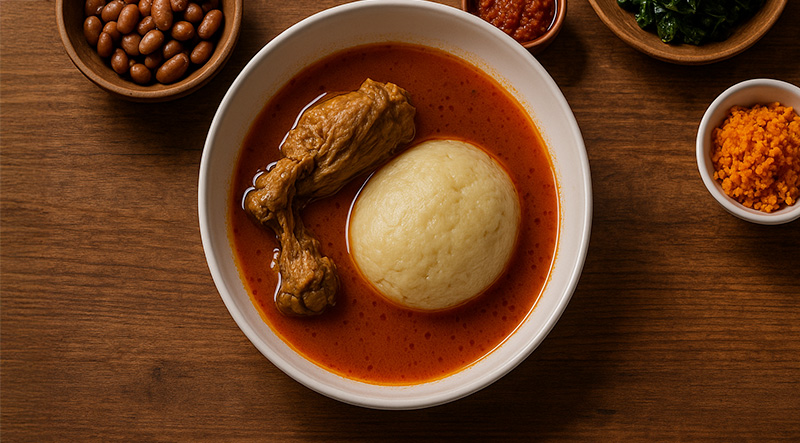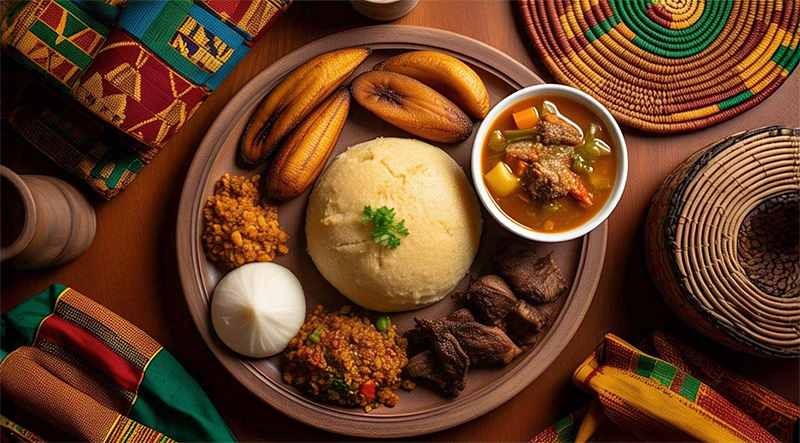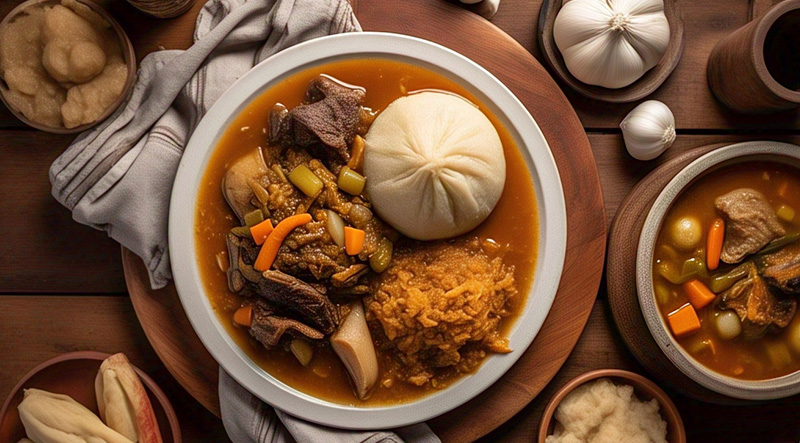Soft, stretchy, and utterly satisfying, Fufu with Light Soup is the heart of Ghanaian comfort food and a soulful symbol of the nation’s rich culinary heritage. This iconic duo brings together the pillowy texture of fufu—made from pounded cassava and plantains—with a steaming, spicy tomato-based broth infused with tender chunks of meat or fish. The soup is light in texture but bold in flavor, and when scooped up with a hand-torn piece of fufu, it delivers a mouthful of warmth, spice, and tradition. It's not just a dish—it's an experience that speaks to family, flavor, and the vibrant spirit of Ghana. Read More...
The History of Ghana’s National Dish: Fufu & Light Soup:
Fufu and light soup are more than just a beloved meal in Ghana—they are a cornerstone of cultural identity, family tradition, and culinary pride. This iconic pairing reflects centuries of history, adaptation, and community in West Africa, where food is often as symbolic as it is satisfying.
What Is Fufu?
Fufu is a starchy, dough-like staple made by pounding boiled cassava, plantains, or yams—or a combination of these—into a smooth, stretchy consistency. It is traditionally pounded in large wooden mortars with heavy pestles, often by two people working rhythmically in tandem. The result is a neutral but slightly sweet base, perfect for pairing with Ghana’s richly seasoned soups and stews.
The name “fufu” comes from the Akan word “fufuo,” meaning “mash” or “mix.” Though versions of fufu exist across West and Central Africa, in Ghana it holds a special place in the national culinary identity—particularly in the Ashanti, Eastern, and Brong Ahafo regions.
The Origins of Light Soup:
Light soup is a clear, tomato-based broth typically made with goat meat, beef, chicken, or fresh fish, and flavored with onions, garlic, ginger, and Scotch bonnet peppers. The word “light” doesn’t refer to the spice level (which can be quite fiery), but rather to the consistency of the soup—it’s thin and broth-like, as opposed to thicker stews like groundnut soup or palm nut soup.
Light soup likely evolved from indigenous Akan preparations, which later incorporated ingredients introduced through trade and colonialism—such as tomatoes and chili peppers from the Americas. The technique of boiling meat and fish with vegetables to create a broth predates colonial times, but the modern tomato-rich version became more widespread in the 19th and 20th centuries.
Ritual, Tradition, and Celebration:
In Ghana, fufu and soup are rarely just lunch or dinner—they’re ceremonial. The pounding of fufu is often a shared, social experience, particularly during family gatherings, festivals, and funerals. It’s a dish that brings generations together, with elders teaching younger family members not just how to cook it, but when and why it’s made.
Light soup is also part of postnatal care traditions, often served to women after childbirth for its warmth, nutrients, and easy digestibility.
Eating fufu and soup is done by hand, with the right hand rolling a small ball of fufu, pressing it into the soup, and swallowing it whole—never chewed. This method enhances the communal, tactile nature of the meal.
A Dish That Crossed Borders:
Today, Ghanaian fufu and light soup are recognized across the world. From Accra chop bars to diaspora kitchens in New York and London, the dish has become a cultural ambassador for Ghanaian cuisine. While modern appliances like blenders and fufu machines have made preparation easier, many Ghanaians still value the traditional mortar and pestle method for its texture and authenticity.
A Legacy in a Bowl:
Fufu with light soup is not just a recipe—it’s a living tradition. It embodies the resilience of Ghanaian cooking, the warmth of family, and the joy of sharing food that’s both simple and deeply flavorful. Its endurance across time and geography is proof that the best dishes are the ones that nourish the soul as much as the body.
Prepare the soup base:

Build the soup:

Prepare the fufu (traditional method):
Quick modern alternatives:

To serve:
The total preparation and cooking time for Fufu with Light Soup is approximately 2 to 3 hours. Preparing the ingredients—including peeling and chopping cassava and plantains, and seasoning the meat—takes about 30–40 minutes. The light soup requires 45 to 60 minutes of simmering for the meat to become tender and the flavors to blend. Meanwhile, the cassava and plantains for the fufu are boiled for about 25–30 minutes, then pounded or blended until smooth, which takes another 15–20 minutes depending on the method. For those using a fufu flour mix, preparation time can be reduced by 20–30 minutes.
A single serving of Fufu with Light Soup, based on the recipe provided and assuming the dish serves six, contains approximately 550 to 700 calories. This estimate includes about 300–350 calories from the fufu (made from boiled cassava and plantain, which are high in carbohydrates), and another 250–350 calories from the light soup, primarily from the goat meat (or other protein), plus the small amounts of oil, tomato, and seasonings. The calorie content may vary depending on the cut of meat used, portion size, and whether additional ingredients like palm oil or smoked fish are added.







